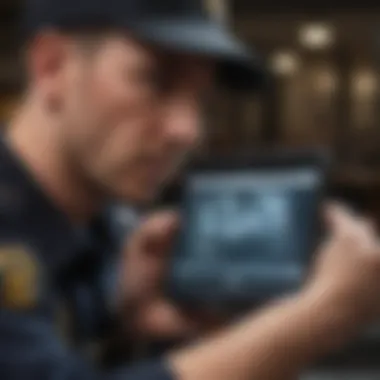How Law Enforcement Verifies Driver Insurance Status


Intro
The mechanisms through which law enforcement can confirm a driver’s insurance status require careful navigation among legal frameworks and technological tools. This exploration sheds light on the implications for drivers. Not only does this information prepare drivers for encounters with law enforcement, it also emphasizes the necessity for transparency and best practices.
Overview of Law Enforcement Access to Insurance Information
The Role of Legal Frameworks
Various laws and regulations govern how officers can obtain relevant insurance data. The access often hinges on state laws, which define the types of information that can be requested during roadside checks. For instance, certain jurisdictions allow officers to contact insurance companies or utilize databases to rapidly verify insurance status. Additionally, legislations such as the Driver's Privacy Protection Act (DPPA) delineate the legal boundaries concerning access to personal information in insurance databases.
Tools Utilized by Law Enforcement
Law enforcement agencies utilize an array of technological tools for streamlined insurance checks, such as:
- Automatic License Plate Recognition (ALPR) systems
- Computer-Aided Dispatch (CAD) software
- Access to interstate databases
These tools enhance the capacity of officers to swiftly determine whether a vehicle has current insurance coverage.
“Timely access to insurance data can mitigate risks for both driver and law enforcement, promoting safety on the road.”
Mechanisms of Access
Scenarios Where Insurance is Checked
Officers often check for insurance during routine traffic stops, accident investigations, or random checkpoints. During these interactions, they may request proof of insurance directly from the driver or utilize their tech tools for immediate verification. Such proactive measures aim to ensure that vehicles on the road comply with state-mandated insurance regulations.
Driver's Rights in these Situations
It is imperative for drivers to understand their rights regarding the disclosure of personal information. In most cases, a driver must present proof of insurance on request. However, the accessibility of insurance data via systems like ALPR suggests an expectation of compliance without always demanding physical documentation.
Best Practices for Insurance Compliance
2-3 key practices can help ensure compliances in drivers:
- Keep proof of insurance in the vehicle at all times.
- Regularly review insurance policy details.
- Promptly update any changes regarding policy coverage.
Adopting these practices fosters a more knowledgeable interaction with law enforcement. Furthermore, consistent data updates strengthen accountability and policy integrity.
End
The Role of Police in Vehicle Insurance Verification
Basic Overview of Police Duties
The duties of police officers are varied and significant in maintaining public safety and order. Officers are responsible for enforcing traffic regulations, investigating crimes, and responding to emergencies. Among these responsibilities is the enforcement of vehicle insurance laws. Law enforcement officers play a crucial role in ensuring compliance with insurance requirements. This role may require officers to conduct checks to verify a driver's insurance status during routine stops or responses to accidents. The abilities of law enforcement agencies to check insurance compliance directly affect the number of uninsured drivers on the roads, thus influencing overall traffic safety. Not only do officers ensure that drivers have valid coverage, but they also safeguard lawful drivers from the risks posed by uninsured individuals.
The Importance of Insurance Compliance
Insurance compliance is critical for various reasons. First, it protects drivers financially in the event of an accident. Drivers who are insured can file claims for their damages, reducing personal financial loss. Without insurance, they are left vulnerable, facing significant liabilities. Second, compliance improves the overall safety of the roads. A registered, insured vehicle is less likely to be involved in serious accidents or incidents, contributing to overall road safety statistics.
Having insurance coverage also has implications for law enforcement. When officers can verify a driver's insurance information easily, it supports their efforts to promote lawful driving behaviors. Knowing that road checks can happen motivates insured drivers to keep their coverage active and up to date, thereby fostering an environment of compliance. The legal permanence tied to insurance cases also brings about standard objectives for police operations, as non-compliance often results in legal consequences for drivers and further administrative burdens for law enforcement agencies.
How Law Enforcement Accesses Insurance Information
As drivers, knowing how law enforcement verifies insurance can inform decisions about policy choices and compliance. Moreover, by exploring the facets of this topic, individuals will uncover intricate details concerning their rights during police encounters, fostering a more informed and responsible approach to managing their insurance needs.


Electronic Databases Used by Police
Law enforcement agencies rely on a range of electronic databases to access vehicle insurance information conveniently. These databases are pivotal in ensuring compliance and enhancing the efficiency of law enforcement duties.
State Databases
State databases form the backbone of local information retrieval concerning insurance coverage. Each state typically maintains its own system, allowing police officers to swiftly check a motorist's insurance status during stops or investigations. The key characteristic of state databases lies in their regional focus, making them relevant for local enforcement needs.
State databases generally offer real-time updates on registered vehicles, thus enabling law enforcement to effectively cross-verify insurance documentation presented during traffic stops. A unique feature of these state systems is the electronic sharing between departments, which streamlines communication and reduces errors that could complicate insurance verifications. One strength of these databases is their direct connection with the Department of Motor Vehicles, ensuring an accurate reflection of the driver's current insurance status. However, a notable limitation could be the variations in how data is handled between states, potentially leading to gaps in information during multistate enforcement actions.
National Databases
On a broader scale, national databases enhance law enforcement's ability to access vehicle insurance records beyond state lines. These databases typically unify data from multiple states, providing a larger pool of information for police use. The primary advantage of national databases is their extensive reach, making it easier for law enforcement to perform insurance checks no matter the driver's current location.
A distinctive aspect of national databases is their integration with various federal programs, which can assist officers in recognizing fraud or uninsured drivers effectively. Although they provide substantial tracking capabilities, national databases also face challenges, such as the dependency on states to deliver up-to-date information. Factors like discrepancies between states can potentially complicate verifications and impact the efficiency originally envisioned for these systems.
Real-Time Insurance Verification Technology
Real-time insurance verification technology represents a significant leap forward in streamlining the process. Using advanced applications, law enforcement can access information almost instantly during interactions with motorists. This technology responds to the pressing need for quick assessments during traffic stops and critical incident responses, minimizing the wait times associated with traditional verification methods. The efficiency of real-time solutions empowers officers to make informed decisions while on duty, enhancing public safety and potentially reducing the number of uninsured motorists on the road.
This technology embodies a proactive approach toward identifying insurance compliance and supporting lawful driving practices. Drivers must, however, remain aware that behavior in the digital age necessitates a more active and informed representation of their insurance status, reducing the risk of unexpected legal challenges.
Legal Framework Governing Insurance Checks
Understanding the regulatory environment surrounding insurance verification is essential for assertaining how law enforcement conducts these checks. This information provides insights not only on the rules governing police practices but also on the rights of drivers. Clear laws create accountability and transparency, demystifying the power law enforcement holds regarding public safety regulations. It lays the foundation for understanding penalty structures, compliance expectations, and the protocols in place to help maintain order in society. Moreover, awareness of this legal framework ensures drivers remain informed about their obligations and rights.
State Laws on Insurance Verification
Every state has its own laws dictating how police can verify vehicle insurance. These regulations dictate if and when law enforcement can check a driver's insurance status and under what circumstances. For example, some states employ a proactive approach, automatically allowing officers access to insurance databases during traffic stops. Others may require more limitations, only providing access in accident situations or suspect engagements.
Key Considerations:
- Privacy Concerns: Legislation usually ensures that insurance information can only be used for official purposes, safeguarding an individual's privacy.
- Variances Across States: The approach can widely vary; staying informed about a specific state's rules is vital.
- Enforcement Mechanisms: Laws determine the consequences of driving without insurance as well, highlighting the importance for citizens to avoid lapses in coverage.
The law holds firm on ensuring all drivers comply with insurance requirements; ignorance of state-specific obligations is not a valid defense.
These laws outline the procedure by which a police officer can access a driver's insurance status and underscore how essential part the legal framework plays in protecting both public interests and drivers' rights.
Role of the in Insurance Compliance
The Department of Motor Vehicles (DMV) acts as a crucial player in managing and enforcing insurance compliance within states. The DMV typically requires drivers to submit proof of insurance when registering a vehicle or renewing a driver's license. Often, this agency maintains detailed records of a driver’s insurance status and shares it with law enforcement agencies, thus acting as a hub for insurance verification. Moreover, communication between the DMV and insurance providers further reinforces compliance oversight.
Primary Functions:
- Data Management: The DMV keeps accurate records of registered vehicles and current insurance policies, allowing smooth verification processes.
- Compliance Enforcement: If a driver fails to maintain valid insurance, penalties such as fines, vehicle registration suspension, or increased scrutiny on future transactions can ensue.
- Education: By providing resources around insurance requirements and compliance guidelines, the DMV strives to ensure public awareness and understanding of these laws.
Understanding the role the DMV plays offers deeper insight into how the verification processes work in tandem with state laws. When driving, the interplay of these systems significantly impacts how law enforcement administers insurance checks on the road.
Possible Scenarios for Insurance Checks
Law enforcement officers encounter various scenarios that necessitate checking a driver's insurance status. These contexts are vital because they not only inform police actions but also keep roads safer and encourage driver compliance with insurance laws. Understanding these scenarios is crucial for both officers and drivers alike. It sheds light on when and why insurance verification occurs. Below, we delve into key situations where insurance information is frequently accessed.
Routine Traffic Stops


Routine traffic stops present a common scenario for insurance checks. During these stops, officers are trained to assess compliance with driving regulations, including verifying insurance coverage. Various indicators can prompt such a check—for example, driving behavior, vehicle condition, or random checks in case of suspected violations.
The importance of checking insurance at this stage cannot be overstated. It serves as an immediate measure to protect the public. Drivers pulled over still have the opportunity to ensure their compliance before potential tickets are issued. Moreover, these interactions foster greater accountability among drivers.
Additionally, becoming aware of potential checks can encourage drivers to keep their documentation updated. Being prepared during a routine stop could significantly lessen the stress of interaction.
Accident Response Situations
when accidents occur, law enforcement agents play a critical role in managing the aftermath. Part of their duty involves verifying insurance on the scene. Knowing a driver’s coverage status can impact how claims are processed and how fault is determined. In these situations, legal and financial implications become sharper.
Furthermore, drivers involved in accidents may benefit from knowing their insurance status upfront. It aids in quick resolution and enhances cooperation between parties involved. Law enforcement can effectively do their jobs when they have immediate access to necessary insurance details.
Effective communication about insurance during such emergencies can support a smoother resolution process, demonstrating the importance of this scenario.
Roadside Checkpoints
Roadside checkpoints are another avenue where law enforcement conducts insurance verifications. At these checkpoints, officers routinely check drivers for criminal activity and compliance with various laws, including having valid insurance.
The function of these checkpoints extends beyond simple law enforcement. They serve as preventive measures to discourage driving without insurance. The visible presence of law enforcement can act as a deterrent against non-compliance, reinforcing safe driving practices within communities.
It's important for drivers to understand their rights at these checkpoints. This knowledge can streamline interactions with law enforcement, minimizing confusion or fear during the check.
Law enforcement uses various scenarios to verify insurance. These scenarios maintain road safety and welfare.
Impact of Technology on Insurance Verification
The integration of technology in law enforcement insurance verification has significantly transformed police operations. It offers a swift and more accurate understanding of drivers' insurance status, facilitating effective resource management and compliance enforcement. The utilization of modern tech solutions aids in streamlining processes, reducing the time spent on administrative checks. Thus, understanding this impact is crucial for both law enforcement and the driving public.
License Plate Recognition Technology
License Plate Recognition (LPR) technology has become a pivotal tool for police during routine checks. This technology captures and reads license plates using cameras mounted on police vehicles or fixed locations. Police officers can swiftly access all relevant insurance information related to the vehicle by processing captured plates against existing databases.
- The advantages of LPR are multiple. It operates in real-time, allowing on-the-spot verification during traffic stops or during surveillance in high-traffic areas. This capability minimizes the chances of uninformed drivers inadvertently operating without valid insurance.
- Furthermore, LPR can facilitate findings related to stolen vehicles and outstanding tickets. This additional layer of efficiency promotes a more secure environment for both officers and the general public.
However, there are considerations. The reliance on LPR calls for stringent regulations to protect civilian privacy rights. Clear policies regarding data retention and use are essential to mitigate concerns regarding misuse or overreach.
Police efficiency and public safety often balance on the knife-edge of technology and personal privacy.
Another critical aspect is the increase in vehicle abandonment during an active LPR field. Drivers with known infractions or insurance lapses might feel pressured into buttons such as troublesome behavior, including flight from the scene. The combination of fast access to necessary data and the broad powers afforded to police increases the gravity of law enforcement encounters.
Mobile Data Terminals and Applications
Mobile Data Terminals (MDTs) and applications are reshaping how officers access insurance information. Devices like these allow police personnel to consult records directly from their patrol cars, eliminating the need for potentially hazardous and time-consuming radio communications.
- MDTs streamline workflow since they offer real-time data retrieval options, insync with databases. Officers can check not only the registration and driving history of a specific vehicle but also whether the driver has valid and current insurance. This effectively closes the loop between initial observation and potential legal infractions.
- Also, modern applications specifically designed for insurance checks enable interactive features that guide officers through compliance processes if further verification is required. It forms part of a data-rich ecosystem, crucial in maintaining public safety.
Despite these advancements, it is necessary to consider the challenges that accompany the deployment of these technologies. User training, device maintenance, and data accuracy are essential factors influencing the overall success of MDTs in the field. An untrained officer or a malfunctioning terminal can negate the effectiveness intended by such technological integrations.
In summary, the role of technology in insurance verification within law enforcement encompasses both remarkable benefits and necessary challenges. As technology continues to evolve, so too will its implications for society's interactions with regulators regarding vehicle operations and insurance compliance.
Consequences of Driving without Insurance
Driving without insurance carries significant legal and financial consequences. Understanding these consequences is crucial for drivers to realize the risks associated with being uninsured. This section covers legal penalties, the financial implications, and the overall importance of having insurance.


Legal Penalties
The legal framework surrounding uninsured driving varies by state. Most governments impose strict penalties aimed at deterring drivers from operating vehicles without proper insurance coverage. Common legal penalties include:
- Fines: These can range from modest amounts to hefty charges, depending on the location and the number of offenses.
- License Suspension: Driving without insurance may lead to the suspension of the driver's license, complicating the ability to legally operate a vehicle in the future.
- Vehicle Registration Issues: In some jurisdictions, vehicles may be impounded or registration revoked, leading to even more severe repercussions.
- Possible Jail Time: Under certain conditions, repeat offenders may even face incarceration.
For instance, in California, the fine for driving without insurance can escalate quickly, and the Department of Motor Vehicles (DMV) may impose further points on a driver’s record, impacting insurance rates dramatically.
Financial Implications
Beyond legal penalties, the financial implications of driving uninsured can be catastrophic. Here are some of the financial risks:
- Increased Premiums: When insurance is reinstated after a lapse, companies often raise premiums, reflecting a higher risk profile due to prior offenses.
- Out-of-Pocket Expenses: In case of accidents, drivers without insurance are obligated to cover all damages and medical bills themselves, which can be financially draining.
- Civil Liability: If found at fault in an accident, drivers risk being sued by the other party involved, potentially leading to significant personal debt.
- Loss of Assets: In severe outcomes, legal judgments can garnish wages or place liens on property, subjecting fiscal stability to long-term distress.
It is always recommended to maintain insurance to avoid escalating situations that can result in both legal and financial turmoil.
In summary, the consequences of driving without insurance should not be underestimated. The combination of legal penalties and financial implications makes maintaining proper insurance coverage essential for all drivers. Understanding and accepting these potential outcomes can help foster better decision-making concerning vehicle insurance.
Best Practices for Drivers
As drivers, understanding the best practices relating to insurance compliance is paramount. Not only does it protect you legally, but it also ensures you remain financially secure in the event of an accident. Adhering to these practices mitigates stress and uncertainty when interacting with law enforcement.
Keeping Insurance Information Updated
Maintaining current insurance information is crucial for all drivers. Many drivers often fail to inform their insurance company when they move, change vehicles, or modify their policy. Doing so can lead to gaps in coverage. Here are ways to keep your information current:
- Update Contact Information: Whenever you move or change phone numbers, inform your insurance agency. This helps avoid any issues in communication.
- Review Policy Regularly: Set reminders to review your policy annually. This allows you to assess if coverage is coherent with current needs.
- Notify About Changes: If your vehicle is damaged or replaced, make sure to report this promptly.
Having accurate and updated information builds a good relationship with your insurer and ultimately protect against unwanted legal consequences during any police stop.
Understanding Your Policy
Comprehending the ins and outs of your insurance policy impacts your ability to handle situations with clarity. Policies vary significantly, leading to confusion for many drivers. Key elements to be aware of include:
- Coverage Types: Understand what type coverage you have - comprehensive, collision, liability, or others. This knowledge shapes your response in an incident.
- Exclusions: Become familiar with what isn't covered. Knowing exclusions prevents unwelcome surprises in the unfortunate event of a claim.
- Claim Procedures: Be informed of how to file a claim properly. Having detailed knowledge may save significant time and effort later when dealing with a stressful situation.
Thorough understanding of your policy aids not only your decision-making process but also helps in effectively managing conversations with law enforcement regarding your insurance status.
Handling Police Interactions
When interacting with police, preparation accelerates a smoother experience. If stopped, there are practices that can ease tension and ensure compliance:
- Stay Calm and Polite: Remain tranquil. Exhibit respect by curtailing any delivery of negativity. This can significantly influence the encounter.
- Provide Documentation Promptly: Have your insurance card and vehicle registration ready to show. This reduces delay and offers transparency to the officer.
- Know Your Rights: Understanding what questions they are allowed to ask empowers you. If in doubt, ask if you are free to leave without providing further information, as this might clarify the situation without escalating tension.
- Be Honest: If you lack insurance, being forthright can potentially humanize the encounter. Specific circumstances can be taken into account.
Preventative measures in understanding police interaction will ease discussions about insurance information verifying procedures.
Drivers who stay informed and address their responsibilities set themselves for greater compliance and improved relationships with law enforcement.
This brings long-term benefits, from preventing potential legal issues to supporting a safer driving experience.
Culmination
- Importance of Legal Awareness: Many drivers underestimate the importance of staying informed about both the legal requirements and potential consequences of driving without valid insurance. Being aware of state laws and how police conduct checks can protect against fines and other legal repercussions.
- Impact of Technology: As technology advances, so does law enforcement's ability to verify insurance status. Recognition tools and mobile data applications mean drivers must be more prudent. It is essential for drivers to understand how these technologies operate, thereby fostering proactive compliance with insurance regulations.
- Best Practices: Keeping insurance information current and understanding one's policy can prevent misunderstandings and facilitate smoother interactions with police. These practices contribute to higher levels of preparation when faced with routine checks or situations such as road accidents.
It's imperative to realize that the police's responsibility is to ensure public safety. In turn, the responsibility of drivers is to have valid insurance and the knowledge necessary to interact with law enforcement effectively. This article serves as a compass for navigating this landscape, fostering educated dialogue around the weight and complexities of insurance verification.
Staying aware empowers drivers to act within the legal framework while protecting their interests. Knowledge and preparationgo hand in hand for responsible driving.
Drivers, young professionals, and students alike should prioritize these discussions—not merely for compliance but to uphold their rights and responsibilities on the road.







